Visiting the United States Naval Academy (USNA), you’re immediately struck by the sight of midshipmen in their sharp uniforms, moving with purpose across the Yard. These aren’t just any clothes; they are symbols of tradition, discipline, and their commitment to naval service. Just as a civilian might have different outfits for work, casual events, and formal occasions, midshipmen have a variety of uniforms, each designated for specific times and events. While the term “Navy Class A Uniform” might evoke images of formal naval dress, understanding the nuances of USNA midshipmen uniforms reveals a system that is both precise and steeped in history. This guide will walk you through the primary uniforms you’ll see at Annapolis, shedding light on their purpose and significance, and helping you understand what might be considered the midshipman’s equivalent of the distinguished “Navy Class A Uniform.”
Precisely Squared Away: The Essence of USNA Uniforms
At the Naval Academy, precision isn’t just a goal; it’s a way of life, and this extends to uniforms. Every detail, from cleanliness and fit to the specific combination of items, is meticulously regulated. Midshipmen must be “squared away,” meaning their uniforms must be impeccable and adhere to strict standards. These standards dictate the required uniform for every event, season, and day. This emphasis on uniform perfection begins on I-Day, their induction day, and continues throughout their careers in the U.S. Navy and Marine Corps. The evolution of these uniforms has a rich history, but throughout time, the importance of wearing the correct uniform, maintained to the highest standard, has remained constant.
The USNA dress code categorizes uniform items into three specifications of wear:
- Required Items (Basic Uniform Components): These are the essential items that must always be worn unless instructed otherwise by a commanding authority.
- Prescribable Items: These uniform items can be authorized or directed to be worn with the basic uniform. The decision to wear them is usually at the discretion of the Unit Commander or individual, unless specific instructions are given.
- Optional Items: These are uniform items purchased at the midshipman’s own expense. They can be worn with the basic uniform at the individual’s discretion, unless restricted.
Midshipmen primarily rotate through five main uniform categories: 1) Plebe Summer, 2) Working, 3) Service, 4) Service Dress, and 5) Dinner (Formal) Dress. While other specialized uniforms exist, these five represent the core wardrobe you’ll observe on the Yard and around Annapolis.
1. Plebe Summer Uniforms: Prepared for the Heat
Plebe Summer, the intensive training period for incoming freshmen (plebes), takes place during Annapolis’s hottest and most humid months. Consequently, the uniforms for this period are designed for comfort and functionality in challenging conditions. The working uniform, detailed below, and the Physical Education (PE) uniform are the mainstays. The PE uniform consists of navy gym shorts, a navy ringed t-shirt, athletic sneakers, and socks.
 Plebes in PE Uniforms during Plebe Summer
Plebes in PE Uniforms during Plebe Summer
Plebes also wear “white works,” a variation that includes the iconic blue-rimmed dixie cup cover (hat). This hat is famously replaced with an upperclassman’s hat upon successfully completing the Herndon Climb, a symbolic rite of passage.
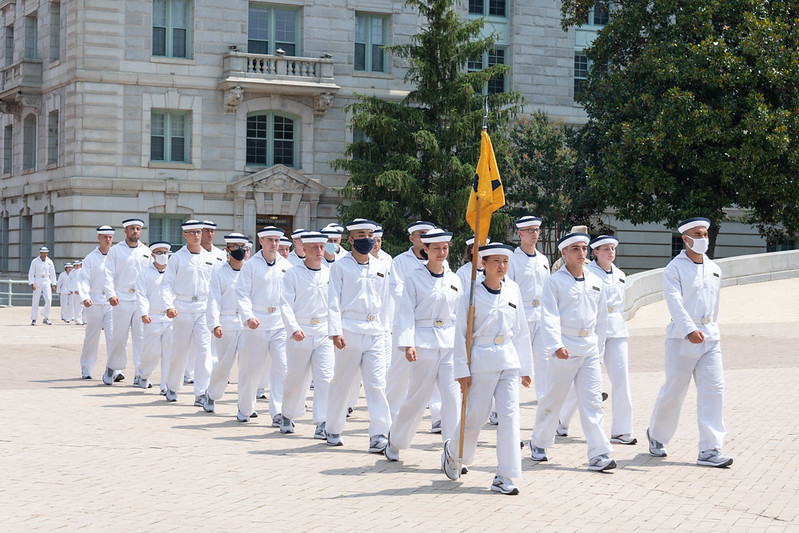 Plebes in "white works" uniforms with dixie cup covers
Plebes in "white works" uniforms with dixie cup covers
2. Working Uniforms: Practical and Functional
Working uniforms are donned when midshipmen’s standard uniforms might become “unduly soiled” or are unsuitable for the task at hand. Currently, the Navy utilizes two types of Navy Working Uniforms (NWU): Type II and Type III. Midshipmen typically wear the Type III NWU for specific training exercises or evolutions. These include Plebe Summer, Anti-terrorism Force Protection (ATFP) drills, and other activities as directed by their Unit Commander.
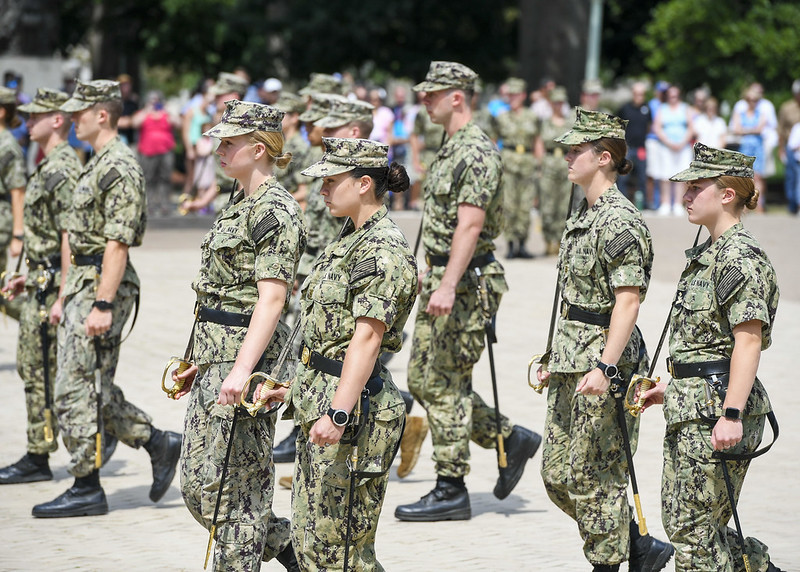 Midshipmen in Type III Navy Working Uniforms during training
Midshipmen in Type III Navy Working Uniforms during training
These uniforms are characterized by an eight-point cap, steel-toed boots for safety, collar insignia indicating rank or status, a name tape for identification, and a U.S. Navy tape. For colder conditions, a prescribable fleece jacket and optional earmuffs can be added to the working uniform ensemble.
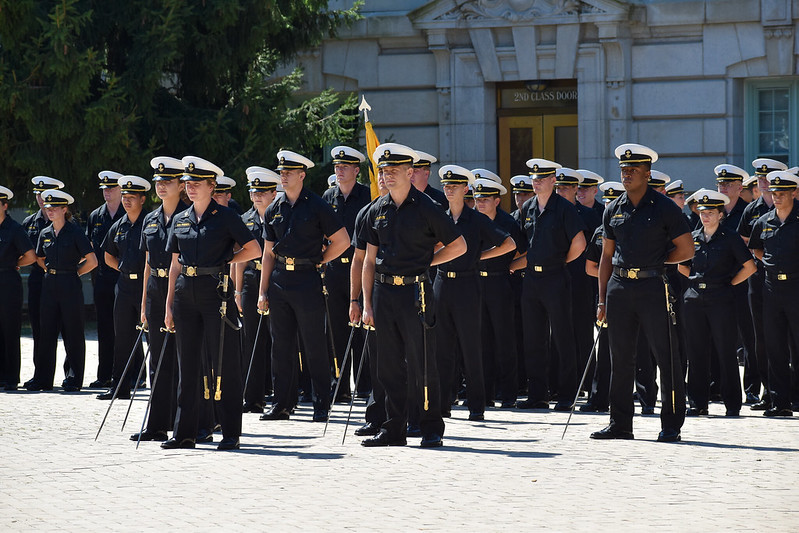 Midshipmen in Working Uniforms in a classroom setting
Midshipmen in Working Uniforms in a classroom setting
During the academic year, the Brigade of Midshipmen often wears a variation of the Working Uniform for classes. This typically involves dark trousers paired with a dark, short-sleeved shirt, maintaining a practical yet presentable appearance for daily academic activities.
3. Service Uniforms: The Everyday Standard
Service Uniforms are the most commonly seen “everyday uniforms” at the Naval Academy. They are designed for routine activities such as attending classes, standing watch, and when designated as the uniform of the day. The service khaki uniform is specifically worn during Summer School, Summer Cruise, Summer Training programs, and by the Plebe Summer Detailers (upperclassmen who train the plebes).
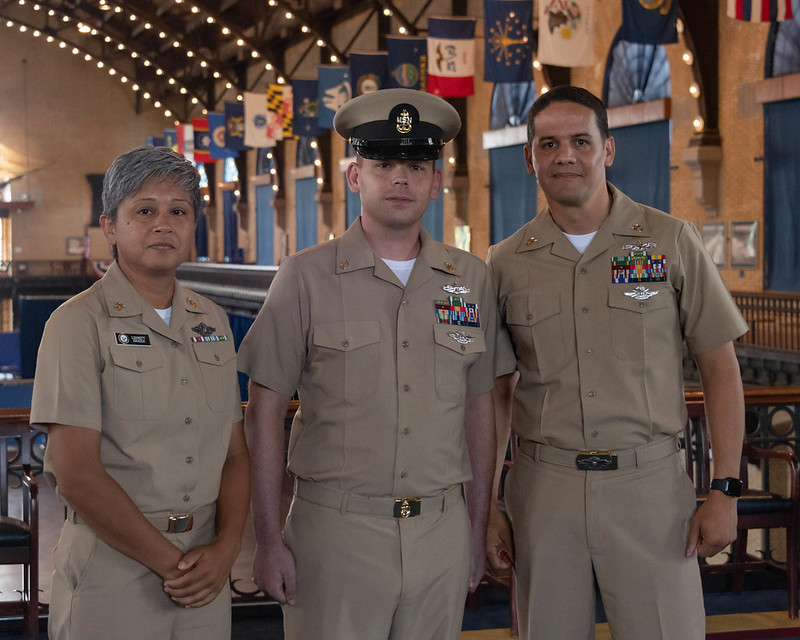 Midshipmen in Service Khaki Uniforms walking on the Yard
Midshipmen in Service Khaki Uniforms walking on the Yard
The service khaki uniform consists of a khaki button-down shirt and trousers for both men and women. It is completed with a Garrison cap, a name tag, collar insignia, and ribbons denoting awards and achievements. Interestingly, swords are even listed as a Prescribable item for this daily Naval Academy uniform, highlighting the traditions embedded in even the most common attire.
4. Service Dress Uniform: Approaching the “Navy Class A Uniform”
For more formal, official functions that don’t quite require the full formality of Dinner Dress, midshipmen wear Service Dress. This uniform is the USNA’s equivalent of a coat and tie, and it’s perhaps the closest to what might be generally considered a “Navy Class A Uniform” in terms of formality and presentation. Service Dress can be seasonal, adapting to geographical and climatic conditions, but it is suitable year-round for official occasions. These occasions include hearings with the Superintendent or Commandant, Academic or Aptitude Boards, and other important events where Formal Dress or Full Dress uniforms are not mandated.
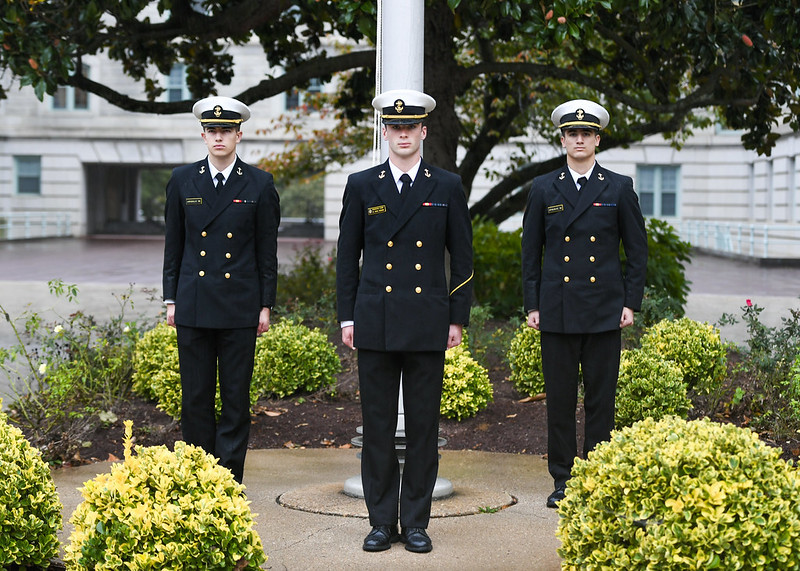 Midshipmen in Service Dress Blue Uniforms at an official event
Midshipmen in Service Dress Blue Uniforms at an official event
The Service Dress uniform comes in different variations, including blue and white. The white version is notably worn for graduation ceremonies by those commissioning into the fleet, while Marine Corps midshipmen wear their distinctive USMC blues.
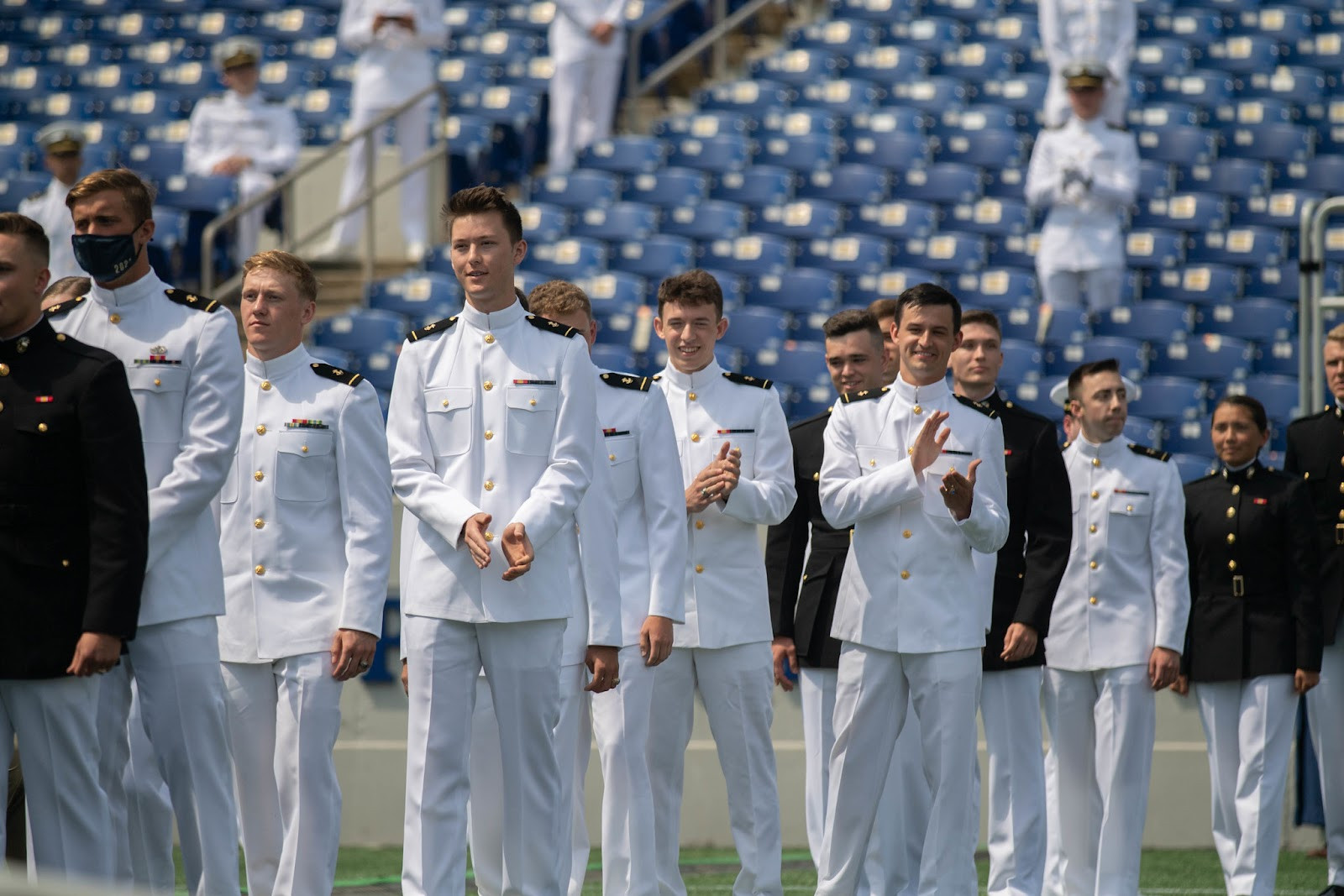 Midshipmen in Service Dress White Uniforms during graduation
Midshipmen in Service Dress White Uniforms during graduation
Both men and women wear a necktie with the blue version (women wear a cross-over neck tab). Service Dress uniforms also feature name tags, large breast insignia, and ribbons. The white version is distinguished by white shoes. Gloves are a Prescribable item, and the ever-practical umbrella is an optional accessory. The Service Dress uniform embodies a level of formality and respect, making it a key part of the midshipman uniform repertoire and aligning closely with the concept of a “Navy Class A Uniform.”
5. Dinner Dress Uniform: The Pinnacle of Formality
Dinner Dress, often referred to as “formal dress,” is reserved for the most significant occasions. These include events like the USNA Ring Dance and formal evening dining events. These Academy dress uniforms are the equivalent of civilian “black tie” attire, representing the highest level of formal wear for midshipmen.
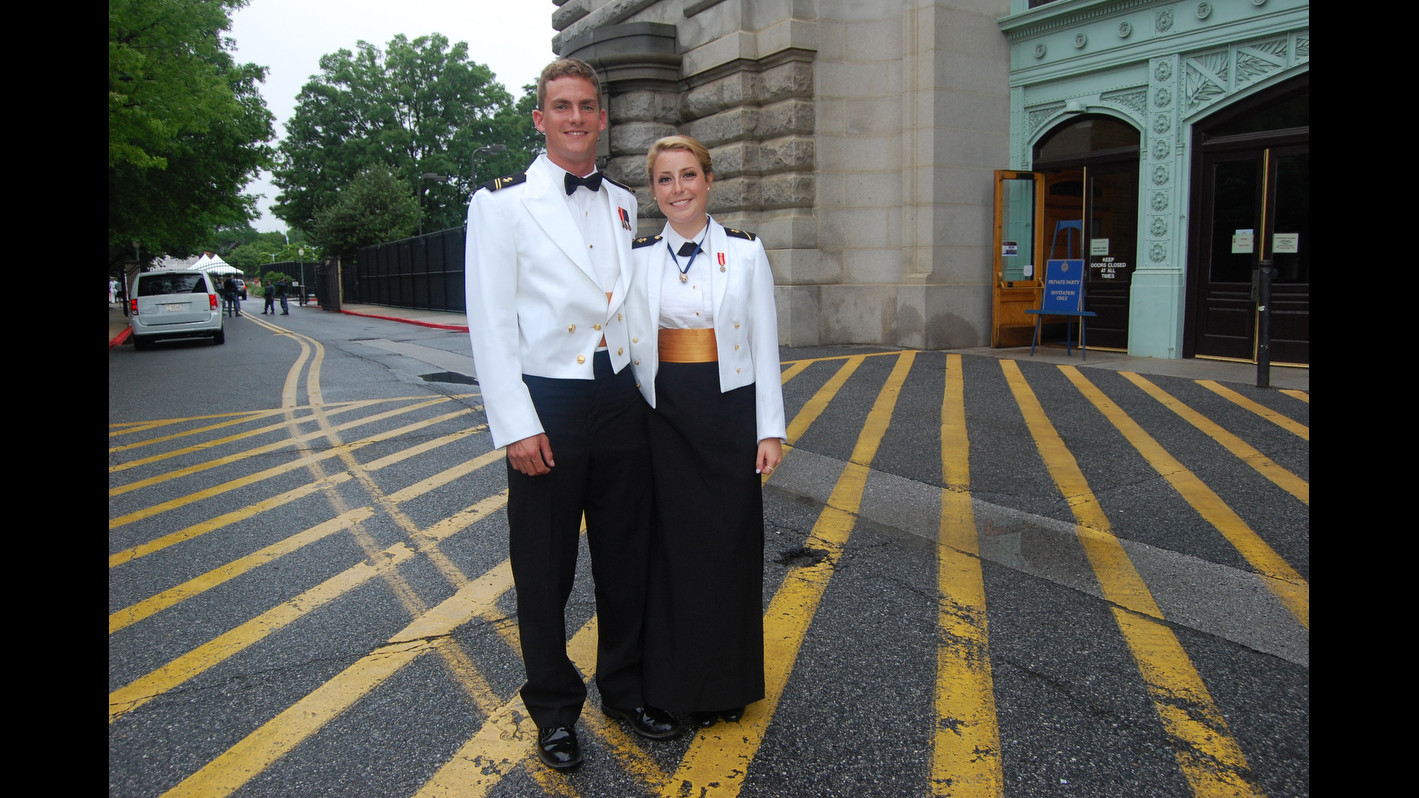 Midshipmen in Dinner Dress Blue Jacket Uniforms at the Ring Dance
Midshipmen in Dinner Dress Blue Jacket Uniforms at the Ring Dance
Dinner Dress offers several variations. Men can wear a double-breasted blue jacket (lower cut), a white version of the same, or “dinner dress blue” with a service dress jacket (for midshipmen yet to receive their dinner dress blue jacket). The darker uniform is suited for winter events, while the white is for summer. All variations include a necktie for men and feature miniature medals and miniature breast insignia, signifying the highest accolades. Leather or white gloves are prescribable, and an umbrella remains an optional, yet sensible, item.
Women’s Dinner Dress options include a black neck tab with the first two jacket variations and a long skirt. With the Dress Blue variation, they wear a cross-over neck tab and can also wear a skirt. Gloves are prescribed for women. Optional accessories include earrings and a handbag (permitted only when off-duty). Like the men’s uniform, an umbrella is advisable for inclement weather.
Seeing the Uniforms in Action
The best way to truly appreciate the variety and significance of USNA midshipmen uniforms is to visit the Naval Academy. Witness the precision of Noon Meal Formation and explore the Yard at your leisure. Remember, when you tour, dine, or shop at USNA, you are directly supporting the Brigade of Midshipmen, as all profits are reinvested in their experience. Come and experience history in the making and see these impressive uniforms firsthand. Welcome aboard the Yard!
[
